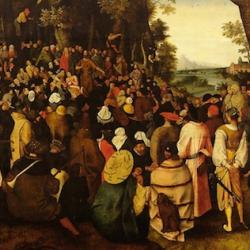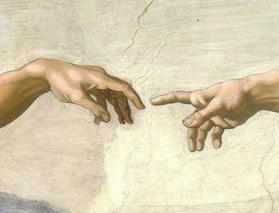Graham Ward begins his book True Religion with a discussion of the use of the word “religion” in Shakespeare’s Romeo and Juliet , and then compares two film versions to explore how the religious theme of the play is handled. The two film versions are Franco Zeffirelli’s and Baz Luhrmann’s. Ward’s analysis of the latter as a fetishization of religious objects and symbols, and in terms of the film’s “irreality” (a variation on Baudrillard’s concept of hyperreality) is particularly striking. A few quotations will suffice to give the flavor:
By comparison with Zeffirelli’s film, “Luhrmann’s world is more hallucinogenic: what is recorded as ‘out there,’ composing the nature of things and actions in the world, is bent continually by the way it is perceived or received. The camera mimics the actors in the scene, adrenalin-rushed and narcotically heightened. People, objects and events are excessive to their material condition, such that what is real remains forever in question. Frequently, Luhrmann films THROUGH other media ?Emirrors, a curtained window, a fish-tank, a drugged state of mind, water. Things never just appear as such; their appearance is always produced ?Ein fact, over-produced. This is what I term the irreality of the film. The French sociologist Jean Baudrillard might term this hyperreality. In 1981 in his provocative book Simulacra and Simulation he writes of the ‘loss of communication’ that both produces or is produced by the ‘escalation of simulacrum,’ such that there is a ‘hyperreality of communication and of meaning. More real than the real, that is how the real is abolished.’ With irreality, reality IS a special effect; and as such it is always and only virtual” (p 27).
“Religious excess is prevalent throughout the film, from the collection of images of the Virgin Mary, saints and angels and the array of votive candles in Juliet’s bedroom, to the tattoo of the cross that covers Friar Lawrence’s back; from the choirs in the church and the images of the sacred heart to the huge canvas of Mary on the staircase of the Capulet mansion. The ultimate expression of this devotional excess is the deathbed scene itself. Romeo locks himself in the echoing spaces of the church. Through a crack in the door he views the nave. The approach to the high altar is flanks by rows of blue-neon crucifixes, flowers, and lamps fashioned like glowing tapers. As we slow track toward the centre of the church the altar has been sreplaced by a catafalque-cum-bed on which Juliet lies, surrounded by a baroque fantasy of candles and statuary. Sex and death are indistinguishable; the bed is the altar on which the two lovers will over themselves eucharistically” (p. 28).
But for Ward the religious possibilities that are in the play itself are not realized in the Luhrmann film: “When Juliet shoots herself we view the scene twice: once from her level and once from above, from the Christic perspective [Ward has pointed to the opening scenes that focus on a Christ figure on top of a church, hands outstretched as if to bring Capulets and Montagues together]. Even so the elevated perspective only permits a certain pity. It achieves not a transcendence but only a distance that betrays an inability to change the situation below, or to intervene. The only transcendence is experience of the spectacular itself; a cheap, commercial transcendence that undermines any potential for tragedy in what happens to Romeo and Juliet” (p 29).
One more: Luhrmann’s “self-conscious staging fuses media with religious hype, just as the transcendent Christi perspective is also a Skycam and an overhead tracking shot. The camera is god-like in its fashioning, framing and in its all-seeing. As such the religious cannot be separated from the theatrical, the cinematic and the aesthetic. . . . in Luhrmann’s world it is not that the cinematic and the religious influence each other, so much as they cannot be discerned to be at all distinct – both mediate, both fetishize, both transcend the human comedy, and both bestow a melodramatic attention on the sign. For both, the content (Catholic doctrine and Shakespeare’s play) take second place to its presentation; and for both a world is created which constantly displaces and frustrates positivist or realist handlings of it. The irony, the play, the excess, the ambiguity, the overcoding are irreducible – and it is this very irreducibility that demands and articulates the assimilation of the religious with a camp aesthetic. Religion is a cultural product and nothing more. The religious worldview does not announce a sacramentum mundi, a moral ordering, an affirmation of the transcendental significance of each person, act, and object . . . . Luhrmann’s production portrays a profound loss of the sacramental in exactly the sites where one might hope it could be found. But the film is not concerned with the possibilities for its restoration” (p. 30-1).
A dense and very provocative analysis.











